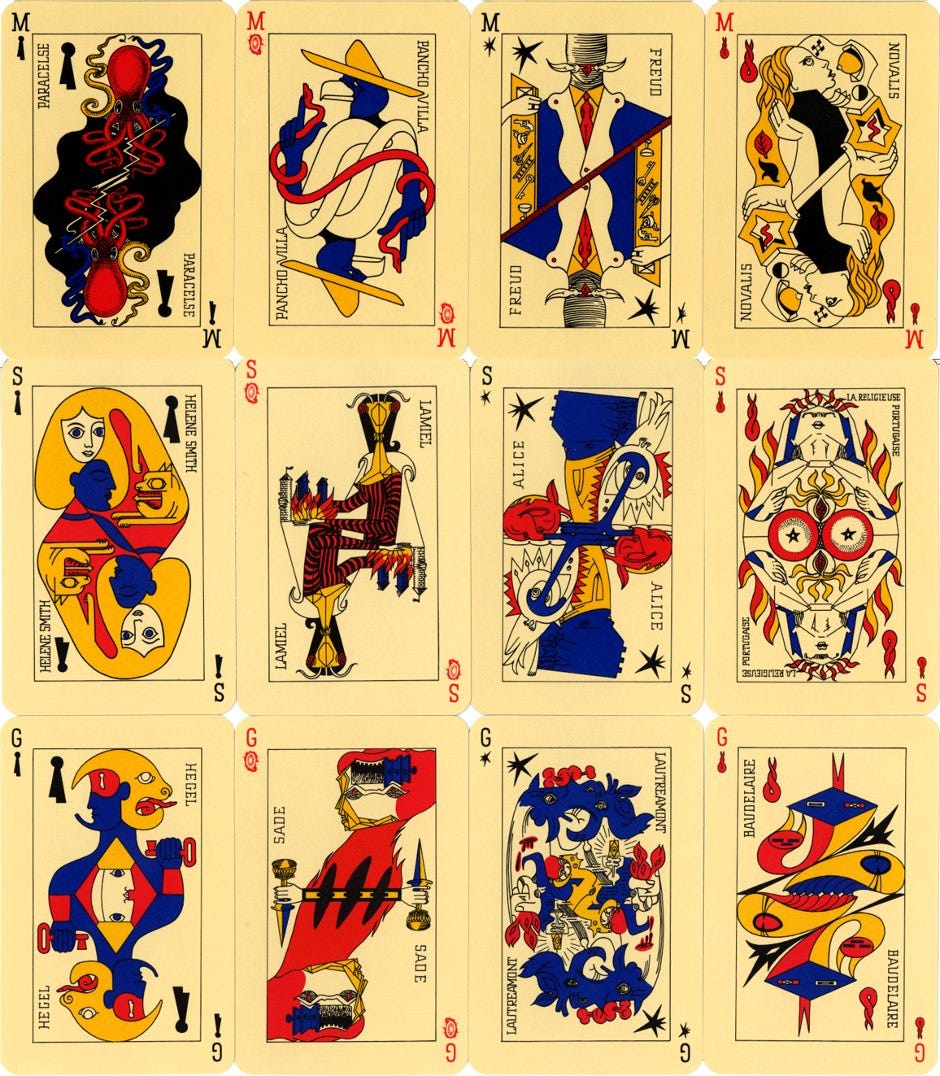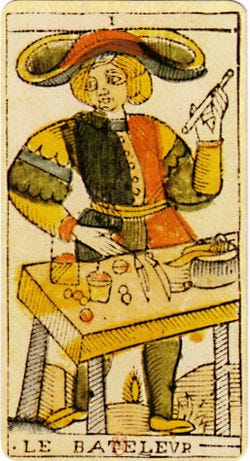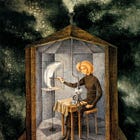Dear coven,
If you have been spending your evenings dabbling with divination, this week’s enchantment might look familiar. Enchantment of the week is a weekly series in which I introduce works of art motivated by magic. For this week I have chosen a painting that reflects the surrealist interest in Tarot cards.
The Surrealist (1947) by Victor Brauner utilises the pictorial language of tarot cards, the Marseille tarot deck, to be exact. The figure in Brauner’s painting is his re-contextualisation of The Magus card, the first Major Arcana card in most tarot decks. The items sprawled before the figure represent the Minor Arcana – Cups, Coins, Swords – while the baton in his hand symbolises the Wands.
Brauner has borrowed this iconography down to the medieval costume and body posture and has placed the figure in the context of Surrealism. His surrealist wields his pen as a magician does his wand. Just as all-natural life is controlled by the Magus, all creative life is at the disposal of the surrealist poet. 1
Playing with the symbolism of card decks was a well-established act in Surrealism. The most literal example of this can be found in the surrealist re-working of the traditional French deck of cards, which they named the Marseille Game (Jeu de Marseille), produced at the same time of Breton’s Fata Morgana poem.
By omitting cards such as the King, Queen, and Jack and replacing them with Magus, Siren and Genius the artists positioned the cards as a cultural and political act. The surrealists’ aim was to deconstruct the bourgeois elements of playing cards and instead introduce a new and liberated design that represented their ideas and values. Notable figures within the cards include Hegel, Hélène Smith, Paracelsus, Lautréamont, Alice in Wonderland, Freud, Marquis de Sade, Baudelaire and Novalis. 2 Brauner was one of the surrealists involved in this project and he was behind the design of the cards illustrating Hegel and medium Hélène Smith.

Victor Brauner’s interest in magic and alchemy was longstanding, though it was further enhanced after the loss of his eye in 1938. Believing himself a visionary of other realms, he formed an obsession with the symbolic potential of his injury. This intensified further in the early 1940s, when he began experimenting with somnambulist-medium methods. 3 If you’re curious to learn about Surrealism’s exploration of mediumship and Spiritualism, have a read of the latest newsletter on the subject.
While The Surrealist can be regarded as a homage to Surrealism’s revolutionary agenda to transform reality through art and poetry, the painting has a profound level of meaning and emerges as a metaphor for the power of life, fertility, and the never-ending cycle of creation. 4
What elements stand out to you in this painting?
I hope you have enjoyed this short introduction to Brauner and his work. If you would like to discover more works motivated by magic, please consider subscribing and following this newsletter’s visual companion.
Tip Jar ☕
Recent articles:
bibliography
Bauduin, Tessel. Surrealism and the Occult: Occultism and Esotericism in the Work and Movement of André Breton. Amsterdam: Amsterdam University Press, 2014.
Kuni, Verena. Victor Brauner: Der Künstler Als Seher, Magier Und Alchimist: Untersuchungen Zum Malerischen Und Plastischen Werk 1940-1947. Frankfurt: Peter Lang, 1995.
Mitchell, Clio. ‘Secrets de l’art Magique Surréaliste”: Magic and the Myth of the Artist-Magician in Surrealist Aesthetic Theory and Practice’. Ph.D Thesis, Courtald Institute of Art, 1993.
Peggy Guggenheim Collection. “The Surrealist | Work of Art | Peggy Guggenheim Collection,” n.d. https://www.guggenheim-venice.it/en/art/works/the-surrealist/.
Subelytė, Gražina, and Daniel Zamani. Surrealism and Magic: Enchanted Modernity. Munich: Prestel, 2022.
Peggy Guggenheim Collection. “The Surrealist | Work of Art | Peggy Guggenheim Collection,” n.d. https://www.guggenheim-venice.it/en/art/works/the-surrealist/.
Bauduin, Surrealism and the Occult, 138-140.
Verena Kuni, Victor Brauner: Der Künstler Als Seher, Magier Und Alchimist: Untersuchungen Zum Malerischen Und Plastischen Werk 1940-1947 (Frankfurt: Peter Lang, 1995) and Clio Mitchell, ‘Secrets de l’art Magique Surréaliste”: Magic and the Myth of the Artist-Magician in Surrealist Aesthetic Theory and Practice’ (Ph.D Thesis, London, Courtald Institute of Art, 1993).
Gražina Subelytė and Daniel Zamani, Surrealism and Magic: Enchanted Modernity (Munich: Prestel, 2022), 108.












Love love